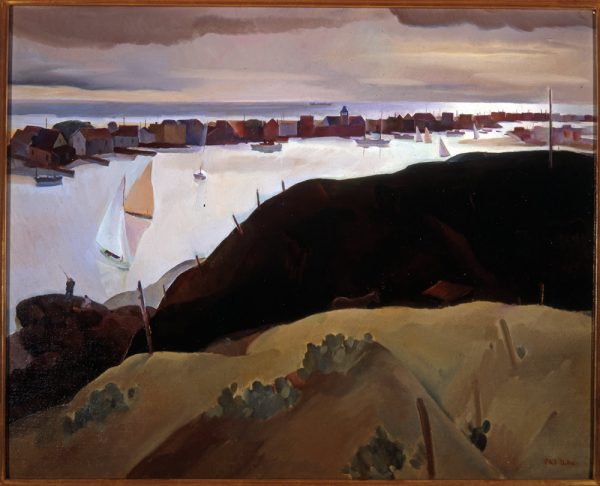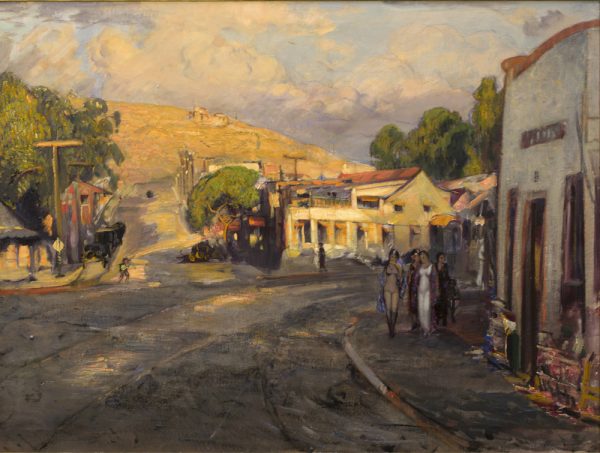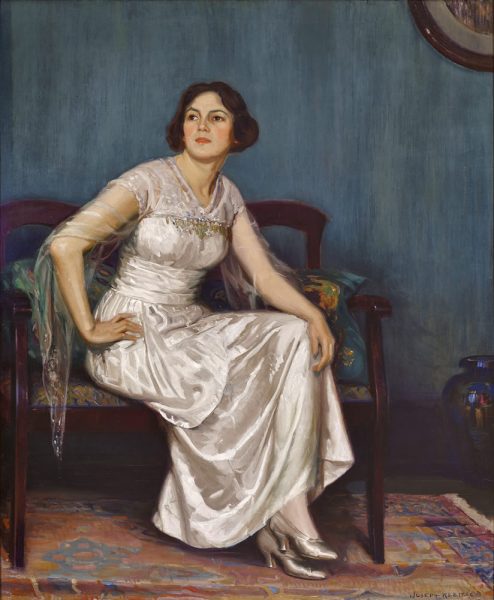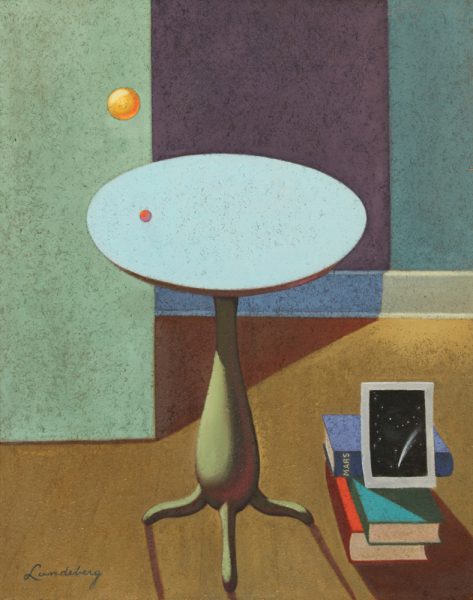The centerpiece exhibition marking the Laguna Art Museum’s centennial offers a surprise to those who assumed its founders, members of the Laguna Beach Art Association, created only landscapes and seascapes in the tradition of the French Impressionist painters.
Museum Director Malcolm Warner said the theme for“Art Colony: The Laguna Beach Art Association 1918-1935”came naturally.
“What better way to celebrate the centennial than to fill our galleries with top-quality works by the artists of the Laguna Beach Art Association– the organization that brought artists and community together and eventually morphed into the museum as we know it,” he said.“I’m especially happy with the paneling, benches and podium that we added to restore our large Steele Gallery to the way it looked when the association opened it in 1929,” Warner said.
One part of the exhibition is devoted to the original gallery, including registers showing sales of paintings and a miniature of the original gallery, made in 1936 by Stanley and Margaret Shepard. Gail Hamilton Hinman carved the figures within.

Two years in the planning, the exhibit focuses on the history of the town’s earliest art group, its relationship with locals, and the attention it attracted in the wider U.S. art world in the early 1900s that put Laguna Beach on the map.
Newspapers, magazines, and genealogical records allowed curators, Janet Blake and Deborah Solon, to explore Laguna’s history and form a sharper picture of the town and the art association as they evolved together. “We wanted to show a wide range of styles and subject matters. In addition we wanted to show works by the best artists of the period,” Blake said.
Solon, an art historian, discusses the early art association at a museum talk Thursday, July 26, and Blake takes up the subject of the Laguna art colony Thursday, Aug. 23.
The exhibit includes works on loan from more than 50 private owners and museums including the Los Angeles County Museum of Art, the National Academy of Design in New York and the Irvine Museum.
Irvine Museum director Jean Sterncalled out a favorite in“Corona del Mar” by Phil Dike, a 1932 view of an area overtaken by change.
Early artist visitors to Laguna Beach included Norman St. Clair, Benjamin C. Brown, Gardner Symons, Jean Mannheim and William Swift Daniell, whose works are on display. Works by longer staying artists Conway Griffith, Frank Cuprien, Edgar Payne, Anna A. Hills,Karl Yens, William Wendt, Joseph Kleitsch, Clarence Hinkle, Ruth Peabody, Eleanor Coburn, Thomas L. Hunt, and George Brandriff are also featured.
Payne is credited with establishing the LBAA with 150 charter members, and securing for a gallery an old wooden building, which had previously served as town hall, school, church and dance hall. It was located where the Hotel Laguna now stands and was offered by a local businessman rent-free.
The LBAA’s membership was open to non-artists as well as artists and it promoted arts education and hosted concerts, lectures and parties year round. Paintings were lent to local schools to foster art appreciation and a junior art association was formed that later helped raise funds to finish the basement of the permanent gallery, now known as the Steele Gallery, which was opened in 1928.

Members of the organization were involved in every civic aspect of the town. The LBAA gallery was an economic engine, both selling paintings and bringing in tourists, the catalogue states.
All the artists painted scenes of the town, which are displayed in the museum’s upstairs gallery, but it was Joseph Kleitsch,who moved to Laguna Beach in 1920, that made a conscious decision to document the community in his work, believing that change was rapidly approaching.
Indeed his “The White House” illustrates what one anonymous visitor from the East told Laguna Life in July of 1923. “The natives have adopted the slogan, The Beach that is Different…this beach is different from any that I have visited. The Coney Island idea is not to be found here. There are no fakes, no midway, no pike or amusements of any kind… Petty thievish and rowdyism are unknown…The female of the species does not believe in being encumbered with too much clothing at the beach; she wears a one-piece bathing suit that exposes her anatomy to the best advantage…appears on the street and does her shopping in a bathing suit…”

In addition to land and seascapes, studies of everyday life such as Guy Rose’s “Woman Sewing,” and Jean Manheim’s “Ironing Day,” are included in the exhibit along with numerous portraits such as “The Artist’s Wife” by Kleitsch, who began his career as a portrait painter. Also featured are still lifes and abundant scenes depicting the old West, including “Abandoned” by Millard Sheets, who spent time in the Chino Hills and was commissioned to execute more than 40 western scenes for Home Savings.
Another surprise in the current exhibit is images of the colony artists and Hollywood stars taken by photographer George Hurrell,who originally was lured to Laguna Beach to paint by Edgar Payne.
Also included are notes and photos from the Laguna Beach Historical Society of the 1921 production of “Kitshi-Manido, The Great Spirit: An Indian Pageant- Play of the Peace Pipe,” written by Isaac J. Frazee, artist, poet, and authority on Southern California Native Americans. A third of the town participated in the play as actors, carpenters, stage hands, publicists and musicians, which was staged in a eucalyptus grove on Arroyo Chico to benefit the LBAA. The second production in 1927 involved 21 performances. Anna Hills inserted a fundraising appeal for a new gallery in the program.
The plays along with the first Festival of Arts in 1932 set the stage for “living pictures,” the forerunner of today’s Pageant of the Masters.

“The period of focus, 1918 to 1935, includeda great variety of styles,” said Blake, who chose Helen Lundeberg’s“The Red Plant” and Fredrick Schwankovsky’s “Woman at the Piano” to represent modernist artists shown by the LBAA.
Solon noted that the modernist artists were not well received and discontinued showing beginning in the later 1930s.

An important work in the exhibition is “Unemployment” by Paul Sample, one of the most noted American scene painters of the 1930s. “It was a gold medal winner at the National Academy of Design, and it was also exhibited with the Laguna Beach Art Association. It is a great Depression-era painting of Los Angeles, but not at all depressing. There is even some humor in the work,” said Blake, noting a sign within the painting about not blocking the sidewalk.
Laguna locals Matt and Mary Lawson, plein air collectors who helped underwrite the show, said, “it’s the finest exhibit we’ve seen at the museum, the best work of each artist is represented.” The show runs through Jan. 13.




